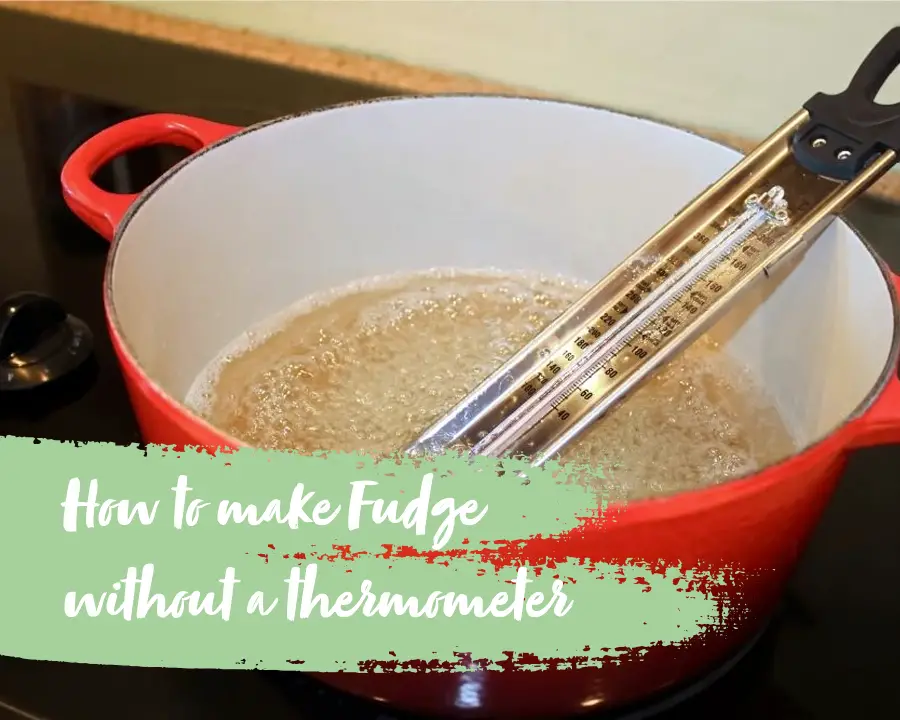Judging when your fudge is done can be the difference between the perfect texture and underdone or overcooked fudge.
If you’re making fudge without a thermometer, you might be wondering: How do you know when fudge is done without a thermometer? You can make fudge without a thermometer by measuring the boiling time, cooling time or through using the “soft ball method”.
In this article, I will cover some important information on making homemade fudge, including how you know when fudge is done without a thermometer.
Keep reading to find out more.
How Do You Know When Fudge Is Done Without A Thermometer?
Fudge needs to be cooked to what is known as the ‘soft ball stage’. That being said, the cooking time can vary depending on the size of the saucepan that you are using to make your fudge.
The easiest way to gauge whether a batch of fudge is ready without a candy thermometer is to do the cold water test. When the fudge has been on the heat for around 10 minutes, you can start to do the cold water test.
To carry out this test, you will need to drop a small amount of the mixture into a bowl of very cold water (but not freezing water).
You know when the fudge is done, because the mixture forms a soft ball in cold water. If the mixture sets in the bowl of cold water and forms a small ball that you are able to squish easily between your fingers, then it is ready to remove from the heat.
This is what it means for the fudge to reach the ‘soft ball stage’.
However, if the mixture sinks into the water, forming a thread, then you will need to continue cooking your fudge for a little while longer.
As you’re doing this without a thermometer, you will need to do the cold water test several times until the mixture reaches this stage.
If you fail to get this part right, you will risk overcooking your fudge and will end up with a dry, crumbly texture if too much of the water evaporates from the mixture as I go into more detail about below.
What Is The Ideal Fudge Texture?
When you’re making fudge, the texture is one of the hardest things to get right. So, what is the ideal fudge texture?
Of course, everyone is going to have their own thoughts on what is the most ideal texture for fudge. This is just how different opinions and preferences work.
However, typically speaking, there is an ideal that you should strive for with every batch of fudge that you make.
Fudge should hold its shape well without being too hard, and most importantly should melt in the mouth with every bite you take! This is what makes it such a rich, delicious treat and why it is so more-ish.
The smaller the sugar crystals in the fudge are, the less you will be able to detect them on the tongue. The less you are able to detect them on the tongue, the more the fudge feels smooth and tastes creamy.
After all, no one likes that unpleasant, gritty feeling of sugar on your tongue as it ruins the whole eating experience.
Bearing this in mind, you want to aim for the smallest sugar crystals possible by cooking the fudge to the right temperature every time.
For the most ideal fudge texture, a temperature of between 234 and 237 °F/ 112 and 114 °C must be maintained. This will ensure the fudge has the ideal concentration of water and sugar, meaning that you get the best results.
Why Is A Thermometer Useful For Making Fudge?
Using a thermometer to make old-fashioned fudge is incredibly useful because it needs to be cooked to a certain temperature.
Making old-fashioned fudge is a challenge in and of itself anyway, but ensuring that you get the texture right when making old-fashioned fudge without a candy thermometer is even tougher.
Unlike easy fudge recipes that don’t require the use of a thermometer, old-fashioned fudge is much more challenging to cook as there is more that can go wrong.
If you undercook your fudge, then you risk it not being able to set properly in the refrigerator.
This is because the less cooking time it has, the less amount of water can evaporate, leaving you with a fudge that is too soft in texture. In the worst case scenarios, if you undercook your fudge it won’t set at all!
On the other hand, if you overcook your fudge, then you will end up with dry, rock hard fudge that is incredibly unpleasant to eat.
This is because you will have allowed too much water to evaporate, rendering the fudge hard and crumbly. Not only is this not very nice in taste, but it also makes the fudge incredibly difficult to cut into neat slices.
Neither option is ideal, and thus the cooking time is crucial when it comes to making old-fashioned fudge. As a result, people like to use a candy thermometer when they make their old-fashioned fudge.
While you can make old-fashioned fudge with the water test, the only way to ensure that you know the exact temperature of the fudge before you take it off the heat is to use a candy thermometer.
Bearing this in mind, for the most consistent results, it’s good to invest in a candy thermometer. This will make your life easier and will also prevent you from the frustration of getting the texture of your fudge wrong time and time again.
After all, making homemade fudge is supposed to be fun! Don’t make it a chore.
In Summary
So, there you have it! After reading this article, you should be able to gauge when fudge is done without a candy thermometer.
However, if you want consistent results and are planning on making old-fashioned fudge that needs to reach a certain temperature regularly, a candy thermometer is a good way to ensure that you get the best fudge.
Good luck and most importantly, have fun!

